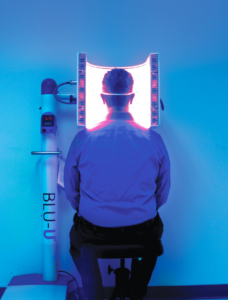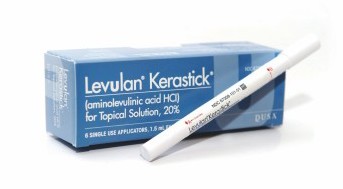Blu-U Treatment for Skin Cancer with Levulan (PDT)

The largest organ in the human body, skin is a sturdy defense that also is amazingly delicate. Skin regularly takes a beating from harsh sunlight, and when not properly protected, can develop lesions that are precancerous or cancerous. While skin cancer occurs more than any other cancer, it’s also highly treatable, especially when caught early on. One option is the Blu-u treatment for precancerous actinic keratosis that utilizes photodynamic therapy with a topical formulation called Levulan.

Levulan, known scientifically as aminolevulinic acid HCl, can help treat common skin problems such as actinic keratoses, precancerous lesions and early-stage carcinomas. When combined with light therapy, Levulan is highly successful in treating the cancerous and precancerous growths.
BLU-U Treatment for Skin Cancer Overview & FAQs
Pros and Cons of Photodynamic Therapy for Skin Cancer
As with any medically significant procedure, photodynamic therapy (PDT) carries its own profile of advantages and risks. Many patients and skin care professionals prefer the noninvasive nature of Blu-U light therapy with Levulan, which largely avoids the infection exposure and other complications that may easily arise from other approaches. While understandably popular, patients must also avoid direct sunlight for several days following treatment. This can be inconvenient for some skin cancer patients. There’s also the risk of other types of complications in some patients that do not occur with straightforward skin cancer surgery, so it’s important to receive your treatment from a dermatologic surgeon who is board-certified and experienced in treating skin cancer.
Why Get Blu-U For Blu-U with Levulan at the Laser and Skin Surgery Center of Indiana?

The chances of a successful outcome with a minimum of side effects is greatest with a professional dermatology practice. The correct execution of Blu-U treatment for skin cancer is especially important. Staffed with highly trained medical personnel, the Laser and Skin Surgery Center of Indiana offers modern facilities and deep familiarity with accurate diagnosis and treatment protocols. In addition to friendly faces and professional expertise during clinical visits, our staff is led by renowned Indiana dermatologist C. William Hanke MD. In addition to being a board-certified dermatologist, Dr. Hanke is also an experienced Mohs surgeon who has published research on skin cancer treatments.
How does BLU-U with Levulan work for skin cancer?
Topically applied aminolevulinic acid, known commercially as Levulan, penetrates the thin upper layer of skin called the epidermis. Approximately two millimeters thick, this layer of skin may develop common skin lesions such as acne vulgaris, actinic keratoses, and basal-cell carcinomas. Subsequent exposure of the infused skin areas to a special blue light causes a biochemical reaction between the Levulan and the affected skin cells. Ideally, this results in increased skin-cell turnover and the production of unblemished collagen that eventually restores skin to a healthier, more attractive appearance.
How is BLU-U with Levulan Administered?

In the first clinical visit after diagnosis, a dermatologist will apply a topical solution from a Levulan Kerastick delivery device that resembles a thick ballpoint pen. This solution must be left alone to soak into the affected areas for approximately one hour. The patient and all nearby personnel will don protective glasses before beginning light treatment. The targeted areas will be exposed to a carefully tuned fluorescent blue light for about 15 minutes before shutting off the machine. Afterward, patients should avoid exposing treated areas to direct sunlight or bright artificial lighting systems such as halogen lamps over the next couple of days and to stay inside if possible.
Who is a candidate for BLU-U with Levulan for skin cancer?
Levulan is suitable for many patients who have actinic keratoses, a precancerous growth.
Is BLU-U therapy painful? Can anesthesia be used?
Depending on the nature and location of the affected areas, the attending dermatologist might anticipate discomfort by proactively applying a topical anesthetic cream. Cold air anesthesia is also very effective.
After completion of a PDT session, some patients will experience light to moderate itching or tingling, prickling or stinging sensations in the affected areas. A few patients may experience a burning sensation, which typically fades away within 24 hours. Oral analgesics such as ibuprofen can be used afterward for minor pain.
How long does the BLU-U treatment for skin cancer take?
The actual PDT session takes about 4 to 15 minutes, but each office visit might last perhaps half an hour to an hour.
How long does it take to see results?
A week to ten days should reveal any improvement, but each patient is different. The attending dermatologist can answer any questions about individual cases. Sometimes, significant improvements may not show clearly until after several sessions.
How long do the results last? Is the cancer gone for good?
Results vary widely among patients. Some patients may experience a recurrence after six months, and other patients may see years go by without further problems. Each individual case must be evaluated and monitored during regular visits with a board-certified dermatologist.
Is there any downtime?
Other than avoiding direct exposure to sunlight such as at the beach or strong indoor lighting, the great majority of patients find it possible to immediately return to their normal activities.
What is the cost of this treatment? Is it affordable for most patients?
Since this is a medically necessary treatment for precancerous growths, your insurance should cover at least a portion of the cost, making this an affordable procedure. We will help you look into your coverage to help you make the best choice for you.
Who should not be treated using Blu-U with Levulan for skin cancer?
Levulan-assisted photodynamic therapy is not for everyone. Certain types of skin cancer, like melanoma, should not be treated with Levulan and PDT. Porphyria patients, patients suffering from systemic lupus erythematosus and individuals who are allergic to porphyrins, aminolevulinic acid or certain other medications may require alternative treatment methods. Individuals who are pregnant, who tend to bleed or bruise easily or who have certain diseases such as HIV or hepatitis should ask their physicians about possible problems with Levulan-assisted phototherapy. A health-care professional will ask questions about any possible problems or contraindications during the initial consultation.
What are the potential complications?
Post-session side effects for treated areas may include skin-color changes, redness or swelling, bleeding or blistering, scaling or crusting of affected areas and itching or stinging sensations. A burning or stinging sensation that persists for longer than four weeks should be reported to your dermatologist. More rarely, Levulan may evoke a strong reaction in a few individuals. Patients experiencing hives, difficulty with breathing or unusual swelling of the lips, tongue, throat or face should immediately contact emergency medical services.
Where can I find before and after photos of skin cancer patients treated with Blu-U with Levulan?
Sun Pharma, the makers of Blu-U and the Levulan Kerastick, have before and after photos of patients treated for actinic keratosis. Many patients have shared their stories and photos on RealSelf.com, showing a 92% “worth it” rating from patients treated with PDT with Levulan for skin cancer.
Where can I get more information about PDT for skin cancer?
To learn more about this therapy, please contact us for a consultation. During this time, we will go over your medical history and answer your questions to set up a personalized skin cancer treatment plan.


